KIA Niro: Initial Response: Identify, Immobilize and Disable
The following procedures should be used whenever you are dealing with a Niro at an emergency scene. All other operations should be consistent with your department's standard operating procedures or guides. When a Hybrid is damaged in a crash, the high voltage safety systems may have compromised and present a potential high voltage electrical shock hazard. Exercise caution and wear appropriate personal protective equipment (PPE) safety gear, including high voltage safety gloves and boots. Remove all metallic jewelry, including watches and rings.
Identify
The Niro is an Eco-electric vehicle. Emergency responders should respond to emergency scenarios involving the Niro accordingly being careful to avoid contact with the high voltage system within the vehicle.

Immobilize
The next step is to immobilize the vehicle to prevent any accidental movement that can endanger response personnel and civilians alike. Although Niro emits virtual sound of engine, if it is damaged in a crash, there may be instances where the vehicle appears to be shut of when it is not due to no engine sound.
When in "READY" mode the lamp is illuminated on the Instrument Panel, the vehicle can move almost silently using the electric motor.
Responders should approach the vehicle from the sides and stay away from the front or rear as they are potential paths of travel.
Immobilizing the vehicle in the following procedure.
Immobilizing the vehicle is the following procedure.
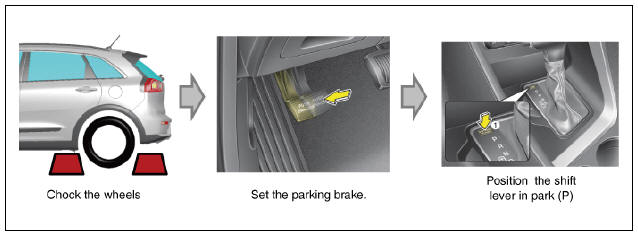
Disable
The final step in the initial response process, conducted after immobilizing the vehicle, is to disable the vehicle, its SRS components and the high voltage electrical system. To prevent current flow through the system, use one of the following procedures to disable the vehicle.
- Disabling the System - Smart Key System and "POWER" START/STOP Button
(1) Confirm the status of the READY light on the instrument panel. If the READY light on the instrument panel. If the
- If the READY light is NOT illuminated, the vehicle is off. Do not push the "POWER" START/STOP button because the vehicle may start.
- To turn off the system, put the shift lever in the P (Park) position and press the POWER button.
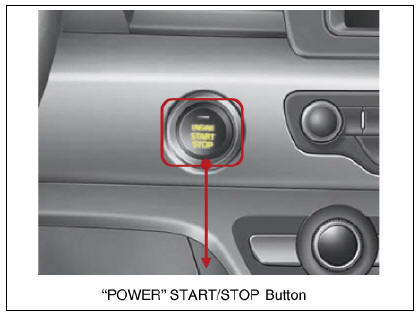
Without depressing the brake pedal


While depressing the brake pedal while a shift lever is in the P (Park) position

(2) If necessary, lower the windows, unlock the doors and open the tail gate as required, before disconnecting the 12V battery.
Once the 12V battery is disconnected, power controls will not operate.
(3) Before disconnecting 12V battery, remove the Smart Key at least 2 meters away from the vehicle to prevent accidental restart.
(4) Use the following procedure to remove the safety plug and disable the high voltage battery:
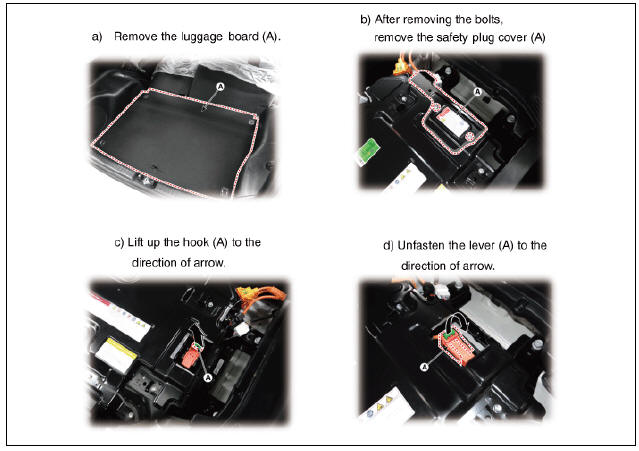
- Disabling the System - IG (Ignition) Fuse Removal
(1) Open the hood.
(2) Remove the engine room fuse box cover.
(3) If necessary, lower the windows, unlock the doors and open the tail gate
as required, before disconnecting the 12V battery
(located in the right side of the luggage room). Once the 12V battery is
disconnected, power controls will not operate.
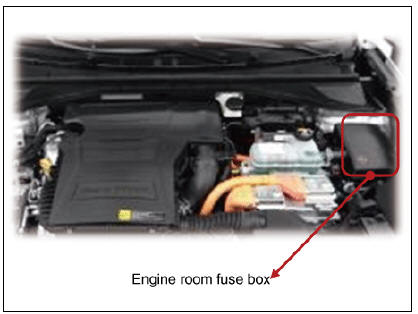
(4) In the event the vehicle may not be disabled using the "Power" START/STOP
Button, pull the IG1, IG2 Fuse from the engine
room fuse box. If the IG Relay cannot be located, pull out all the fuses and
relays in the fuse box.
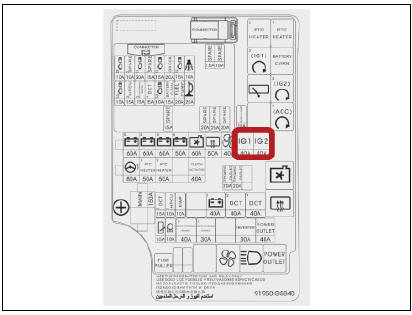
(5) Remove the safety plug and disable the high voltage battery
(Refer to No.5 procedure in page 15) If previously mentioned methods of disabling system are unsuccessful, the vehicle is not secured from accidental deployment of undeployed airbags and electric shock of high-voltage components.
Warning
Electrocution Risk
- Before engaging in emergency response procedures, ensure the vehicle is disabled and wait 5 minutes to allow the capacitor in the high voltage system to discharge to avoid electrocution.
- Exposed cables or wires may be visible inside or outside the vehicle. Never touch the wires or cables before disabling the system, to prevent injury or death due to electrical shock.
Failure to follow these instructions can lead to death by electrocution.
Extraction Operations
The Niro is an Eco-electric model (HEV/PHEV). Because of the high voltage components contained therein, first responders should pay special attention when they extract occupants in the car. Before extraction operations, the first responders should "Identify, Immobilize and Disable"
READ NEXT:
 Vehicle Stabilization
Vehicle Stabilization
Use standard stabilization (cribbing) points, as shown beside. Always be sure
to connect to a structural member of the vehicle and
avoid placing cribbing under high voltage cables, fuel lines and other areas not
normally considered acceptable.
 Roadside Assistance
Roadside Assistance
Towing
In the event of an accident, the high voltage system must be disabled. The
safety plug must be
removed from the high voltage battery according to one of the methods described
in sections of page
17-20 to disable the vehicle.Towing Niro
SEE MORE:
 Troubleshooting - Brake System
Troubleshooting - Brake System
Symptom :
Lower pedal or sponge pedal
Expected cause → Countermeasure
Brake system (oil leakage) → Repair
Brake system (air inflow) → Air bleeding out
procedure
Piston seal (worn out or
damaged) → Re
 LCD display messages
LCD display messages
Shift dial SBW type of LCD display messages
Message/ Content
A: Shifting conditions not met. Reduce speed, then shift
When driving speed is too fast to shift the gear.
A: Error. Press brake and shift to R and then D
When the brak
Categories
- Home
- KIA Niro EV, Hybrid - Second generation - (SG2) (2021-2024) - Owner's manual
- Kia Niro - First generation - (DE) (2017-2022) - Service and Repair Manual
- Contact Us
